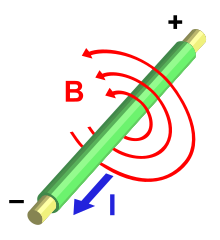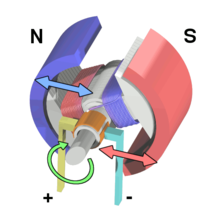Main article: Electromagnetism
Ørsted's discovery in 1821 that a magnetic field existed around all sides of a wire carrying an electric current indicated that there was a direct relationship between electricity and magnetism. Moreover, the interaction seemed different from gravitational and electrostatic forces, the two forces of nature then known. The force on the compass needle did not direct it to or away from the current-carrying wire, but acted at right angles to it.[30] Ørsted's slightly obscure words were that "the electric conflict acts in a revolving manner." The force also depended on the direction of the current, for if the flow was reversed, then the force did too.[45]Ørsted did not fully understand his discovery, but he observed the effect was reciprocal: a current exerts a force on a magnet, and a magnetic field exerts a force on a current. The phenomenon was further investigated by Ampère, who discovered that two parallel current-carrying wires exerted a force upon each other: two wires conducting currents in the same direction are attracted to each other, while wires containing currents in opposite directions are forced apart.[46] The interaction is mediated by the magnetic field each current produces and forms the basis for the international definition of the ampere.[46]
Experimentation by Faraday in 1831 revealed that a wire moving perpendicular to a magnetic field developed a potential difference between its ends. Further analysis of this process, known as electromagnetic induction, enabled him to state the principle, now known as Faraday's law of induction, that the potential difference induced in a closed circuit is proportional to the rate of change of magnetic flux through the loop. Exploitation of this discovery enabled him to invent the first electrical generator in 1831, in which he converted the mechanical energy of a rotating copper disc to electrical energy.[47] Faraday's disc was inefficient and of no use as a practical generator, but it showed the possibility of generating electric power using magnetism, a possibility that would be taken up by those that followed on from his work.
Faraday's and Ampère's work showed that a time-varying magnetic field acted as a source of an electric field, and a time-varying electric field was a source of a magnetic field. Thus, when either field is changing in time, then a field of the other is necessarily induced.[48] Such a phenomenon has the properties of a wave, and is naturally referred to as an electromagnetic wave. Electromagnetic waves were analysed theoretically by James Clerk Maxwell in 1864. Maxwell developed a set of equations that could unambiguously describe the interrelationship between electric field, magnetic field, electric charge, and electric current. He could moreover prove that such a wave would necessarily travel at the speed of light, and thus light itself was a form of electromagnetic radiation. Maxwell's Laws, which unify light, fields, and charge are one of the great milestones of theoretical physics.[48]
Electric circuits
Main article: Electric circuit

A basic electric circuit. The voltage source V on the left drives a current I around the circuit, delivering electrical energy into the resistor R. From the resistor, the current returns to the source, completing the circuit.
The components in an electric circuit can take many forms, which can include elements such as resistors, capacitors, switches, transformers and electronics. Electronic circuits contain active components, usually semiconductors, and typically exhibit non-linear behaviour, requiring complex analysis. The simplest electric components are those that are termed passive and linear: while they may temporarily store energy, they contain no sources of it, and exhibit linear responses to stimuli.[49]
The resistor is perhaps the simplest of passive circuit elements: as its name suggests, it resists the current through it, dissipating its energy as heat. The resistance is a consequence of the motion of charge through a conductor: in metals, for example, resistance is primarily due to collisions between electrons and ions. Ohm's law is a basic law of circuit theory, stating that the current passing through a resistance is directly proportional to the potential difference across it. The resistance of most materials is relatively constant over a range of temperatures and currents; materials under these conditions are known as 'ohmic'. The ohm, the unit of resistance, was named in honour of Georg Ohm, and is symbolised by the Greek letter Ω. 1 Ω is the resistance that will produce a potential difference of one volt in response to a current of one amp.[49]
The capacitor is a device capable of storing charge, and thereby storing electrical energy in the resulting field. Conceptually, it consists of two conducting plates separated by a thin insulating layer; in practice, thin metal foils are coiled together, increasing the surface area per unit volume and therefore the capacitance. The unit of capacitance is the farad, named after Michael Faraday, and given the symbol F: one farad is the capacitance that develops a potential difference of one volt when it stores a charge of one coulomb. A capacitor connected to a voltage supply initially causes a current as it accumulates charge; this current will however decay in time as the capacitor fills, eventually falling to zero. A capacitor will therefore not permit a steady state current, but instead blocks it.[49]
The inductor is a conductor, usually a coil of wire, that stores energy in a magnetic field in response to the current through it. When the current changes, the magnetic field does too, inducing a voltage between the ends of the conductor. The induced voltage is proportional to the time rate of change of the current. The constant of proportionality is termed the inductance. The unit of inductance is the henry, named after Joseph Henry, a contemporary of Faraday. One henry is the inductance that will induce a potential difference of one volt if the current through it changes at a rate of one ampere per second.[49] The inductor's behaviour is in some regards converse to that of the capacitor: it will freely allow an unchanging current, but opposes a rapidly changing one.


No comments:
Post a Comment